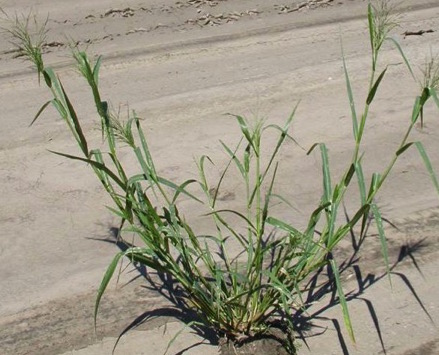Description
Taken from Missouri Weed ID Guide: https://myfields.info/node/add/weeds
| Weed Description: A summer annual with large round, smooth sheaths that are often bent at the nodes. This weed may reach 7 feet in height and is found throughout most of the United States in various agronomic and horticultural crops, turfgrass, nurseries, landscapes, and noncrop areas. A primary identifying characteristic of this grass weed is the zigzagged growth pattern it takes on due to bending at the nodes. |
| Seedlings: Fall panicum seedlings are much different from the mature plants in that the seedlings have many hairs on the lower surface of the leaf blades. Leaves are rolled in the shoot, the ligule is a fringe of hairs to 2 mm in length, and auricles are absent. |
| Leaves: Rolled in the shoot, 15 to 20 mm wide, 4 to 20 inches long, and auricles are absent. The ligule is a fringe of hairs reaching 2 to 3 mm in length and is often fused at the base. Leaf blades have a conspicuous midvein and are smooth above but sometimes slightly hairy near the leaf tip or leaf base. The lower leaf surfaces of mature plants are without hairs (glabrous) and glossy. |
| Stems: Stems are without hairs (glabrous), round, and sometimes glossy. Nodes along the stem are usually swollen and bent in different directions, which contributes to the rather unusual growth habit of this weed. |
| Flowers: The seedhead is a wide, spreading panicle that develops a purplish tint when mature. Individual spikelets are yellow and approximately 3 mm long by 2 mm wide. |
| Roots: A fibrous root system with stems that are capable of rooting at the nodes. |
| Identifying Characteristics: Fall Panicum is often mistaken for Johnsongrass (Sorghum halepense) or Barnyardgrass(Echinochloa crus-galli) prior to seedhead formation. However, johnsongrass has a membranous ligule unlike that of fall panicum and johnsongrass seedlings also do not have hairs on the lower leaf surface like those of fall panicum. Additionally, barnyardgrass does not have a ligule at all and barnyardgrass seedlings might only have hairs near the leaf base. |
Pest image (all)

Scientific name
Panicum dichotomiflorum
Pest photo source
Dr. Dallas Peterson, Agronomy, KSU
Weed type
grass
Production period
Preharvest
Weed life cycle
summer annual
